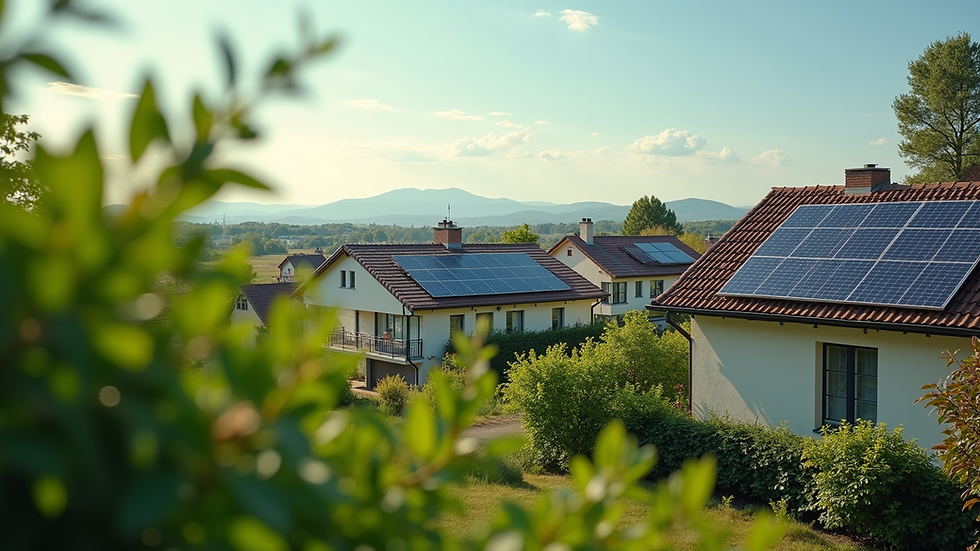Discover the Benefits of Sustainable Communities
- farrakhan Muhammad
- Aug 5
- 3 min read
Sustainable communities are transforming the way we live, work, and interact with our environment. These communities focus on creating a balance between social, economic, and environmental needs to ensure a healthy and thriving future for all residents. By adopting sustainable practices, communities can reduce their ecological footprint, improve quality of life, and foster stronger social connections.

What Are Sustainable Communities Explained?
Sustainable communities are designed to meet the needs of the present without compromising the ability of future generations to meet their own needs. This means integrating eco-friendly infrastructure, promoting social equity, and supporting local economies. These communities prioritize renewable energy, efficient transportation, green spaces, and waste reduction.
For example, a sustainable community might include:
Energy-efficient homes that use solar panels and insulation to reduce energy consumption.
Public transportation options like bike lanes and electric buses to lower carbon emissions.
Community gardens and parks that provide green space and promote local food production.
Recycling and composting programs to minimize landfill waste.
By focusing on these elements, sustainable communities create healthier environments and foster a sense of belonging among residents.
Environmental Benefits of Sustainable Communities
One of the most significant advantages of sustainable communities is their positive impact on the environment. These communities reduce pollution, conserve natural resources, and protect biodiversity. Here are some key environmental benefits:
Lower Carbon Footprint
Sustainable communities use renewable energy sources such as solar, wind, and geothermal power. This reduces reliance on fossil fuels and decreases greenhouse gas emissions.
Improved Air and Water Quality
Green spaces and reduced vehicle traffic help improve air quality. Sustainable water management practices, like rainwater harvesting and wastewater recycling, protect local water sources.
Waste Reduction
By encouraging recycling, composting, and responsible consumption, sustainable communities minimize the amount of waste sent to landfills.
Preservation of Natural Habitats
Thoughtful urban planning ensures that natural areas are preserved, supporting wildlife and maintaining ecological balance.
Implementing these practices not only benefits the planet but also enhances the health and well-being of community members.

Social and Economic Advantages
Sustainable communities also offer numerous social and economic benefits. They create environments where people can thrive both personally and professionally.
Stronger Social Connections
Shared spaces like parks, community centers, and gardens encourage interaction and cooperation among residents. This builds trust and a sense of belonging.
Healthier Lifestyles
Access to green spaces and walkable neighborhoods promotes physical activity and mental well-being.
Economic Resilience
Supporting local businesses and sustainable industries creates jobs and keeps money circulating within the community.
Affordable Living
Energy-efficient homes and reduced transportation costs help lower living expenses.
For instance, a community that invests in local farmers' markets and renewable energy projects can stimulate the local economy while reducing environmental impact.
How to Build a Sustainable Community
Creating a sustainable community requires collaboration, planning, and commitment. Here are practical steps to get started:
Engage Residents
Involve community members in decision-making to ensure their needs and ideas are considered.
Develop Green Infrastructure
Invest in renewable energy, efficient public transit, and green building materials.
Promote Local Food Systems
Encourage community gardens, farmers' markets, and urban agriculture.
Implement Waste Management Programs
Establish recycling, composting, and education initiatives.
Enhance Public Spaces
Create parks, trails, and recreational areas that are accessible to all.
Support Social Equity
Ensure affordable housing and access to essential services for everyone.
By following these steps, communities can gradually transition toward sustainability and enjoy its many benefits.

Embracing the Future with Hereafter Community
One inspiring example of sustainable living is the hereafter community, which integrates eco-friendly design with a strong focus on social well-being. This community exemplifies how thoughtful planning and innovation can create a vibrant, resilient environment for residents.
By learning from such models, other communities can adopt similar strategies to improve their sustainability and quality of life.
Moving Toward a Sustainable Tomorrow
Sustainable communities are more than just a trend - they are a necessary shift toward a healthier planet and society. By embracing sustainable practices, communities can reduce environmental impact, foster social connections, and build economic resilience.
Whether you are a resident, planner, or policymaker, understanding the benefits and strategies of sustainable communities is essential. Together, we can create places where people and nature thrive side by side.
.png)



Comments